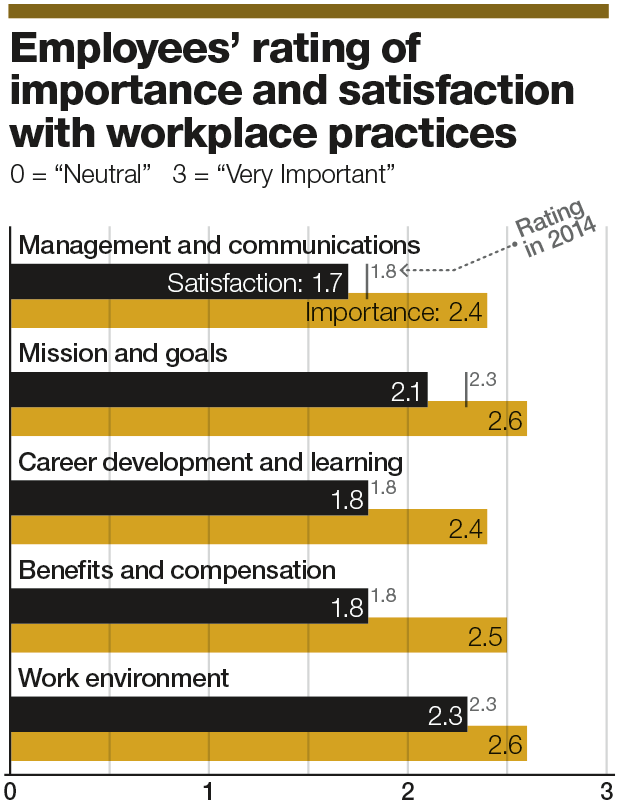Striving for social equity is the mission of many nonprofits, and this year’s 100 Best Nonprofits to Work For in Oregon survey shows employees are most satisfied with their organizations’ fair treatment of differing racial, gender, disability, age and economic groups. But as a national discourse about racial discrimination and equity for low-income groups takes center stage, data show Oregon’s 100 Best Nonprofits to Work For still need to make progress on addressing these issues within their own organizations.
Striving for social equity is the mission of many nonprofits, and this year’s 100 Best Nonprofits to Work For in Oregon survey shows employees are most satisfied with their organizations’ fair treatment of differing racial, gender, disability, age and economic groups. But as a national discourse about racial discrimination and equity for low-income groups takes center stage, data show Oregon’s 100 Best Nonprofits to Work For still need to make progress on addressing these issues within their own organizations.
Employees at this year’s 100 Best Nonprofits to Work For in Oregon have the highest average satisfaction rate with their organizations’ fair treatment of minority and gender groups. This bears out in the data on gender parity within senior management. The percentage of women who hold senior management roles at the 100 Best Nonprofits is 65%, a much higher rate than at for-profit companies.
But survey data show the sector still lags behind on hiring racial minorities to senior executive positions. The percentage of racial and ethnic minorities in senior management at the 100 Best Nonprofits this year is 15%, a one percentage point increase on last year’s list but still low compared with the proportion of female executives.
Public discourse around racial discrimination has gained momentum this year following high-profile cases of deaths of black men and women in police custody. For example, newly created social equity groups, such as Black Lives Matter, have gained prominence by using social media and street protest to advocate for change. As the nonprofit sector takes an increasing role in addressing inequities among minorities to reflect social change at the national level, more emphasis could also be given to addressing inequities in its own management ranks.
The same could be said for the nonprofit sector’s approach to compensation and benefits. This year’s 100 Best Nonprofits are least satisfied with opportunities for increase in pay and benefits. One of the biggest gaps between how satisfied employees are with a workplace practice and the importance they attach to it is with their employers’ willingness to increase salary and benefits.
It is not surprising that constraints on nonprofits’ budgets would mean limited salaries for employees. Yet this gives rise to a contradiction in the nonprofit sector: Many nonprofits pay low salaries while advocating for better economic opportunities for low-income groups. Jim White, executive director of the Nonprofit Association of Oregon, says the way that nonprofits are funded makes it difficult for organizations to pay decent wages to their staff. Many organizations receive funds from the government to operate their programs, but this money is “never enough to run the programs,” says White.
Nonprofits are forced instead to look for funds to pay administrative costs from earned revenue, such as fees they charge for a particular service, or from revenue from private individuals and foundations. But this money is often restricted. It can also be difficult to find private donors who are willing to give money solely for administrative expenses.
“We have heard from nonprofits that they are not happily giving their staff minimum wage. They would love to find sustainable business models that would allow for them to give their staff more,” says White. “They are regularly challenged by their ability to leverage the money that it takes to pay for administrative or overhead costs.”

Improving wages and benefits for workers is becoming a much-talked-about issue locally and nationally. In June this year, Oregon passed a statewide mandatory paid sick-leave law — the fourth U.S. state to do so. The law requires Oregon employers to provide, in most cases, up to 40 hours of paid sick leave to employees a year starting January 1, 2016.
A similar discussion surrounds increasing the minimum wage. In Oregon there are proposals to increase the minimum wage to as much as $15 an hour from the current $9.25 rate, mirroring similar discussions at the federal level. But while raising the minimum wage would help improve the lot of poor working families, it also threatens the operations of the very nonprofits that serve these groups. The Nonprofit Association of Oregon conducted a survey of nonprofits to collect feedback about the effects of raising the minimum wage on the sector. While some responded it is vitally important and should be raised as soon as possible, others said it would be an “incredible challenge to programs,” says White.
Nonprofits can take steps to manage their money better by ensuring they have adequate reserves set up to pay their staff, says White. Many organizations run a tight budget that does not leave much cushion for overhead costs. In fact, most nonprofits have only one to three months of reserves on hand to cover operational costs, says White. “That means that in 90 days they don’t know how they will pay their staff.” One solution is for nonprofits to partner more with philanthropic organizations and foundations to raise support for administrative overhead. “It is something we have raised with nonprofits to fight for: that their overheads are real costs that shouldn’t be seen as not vital to the running of the organization,” says White.
{jumi [includes-for-articles/100-Best-nonprofit-2015.html]}





